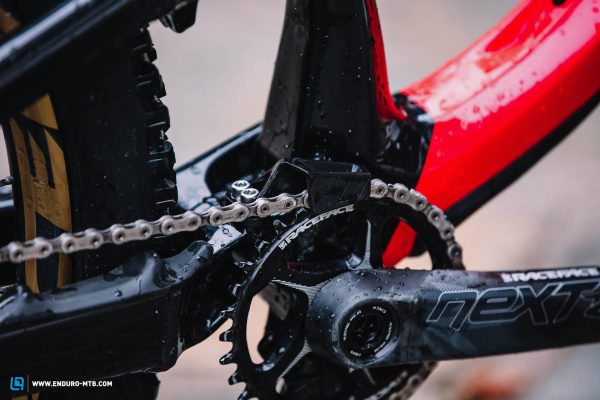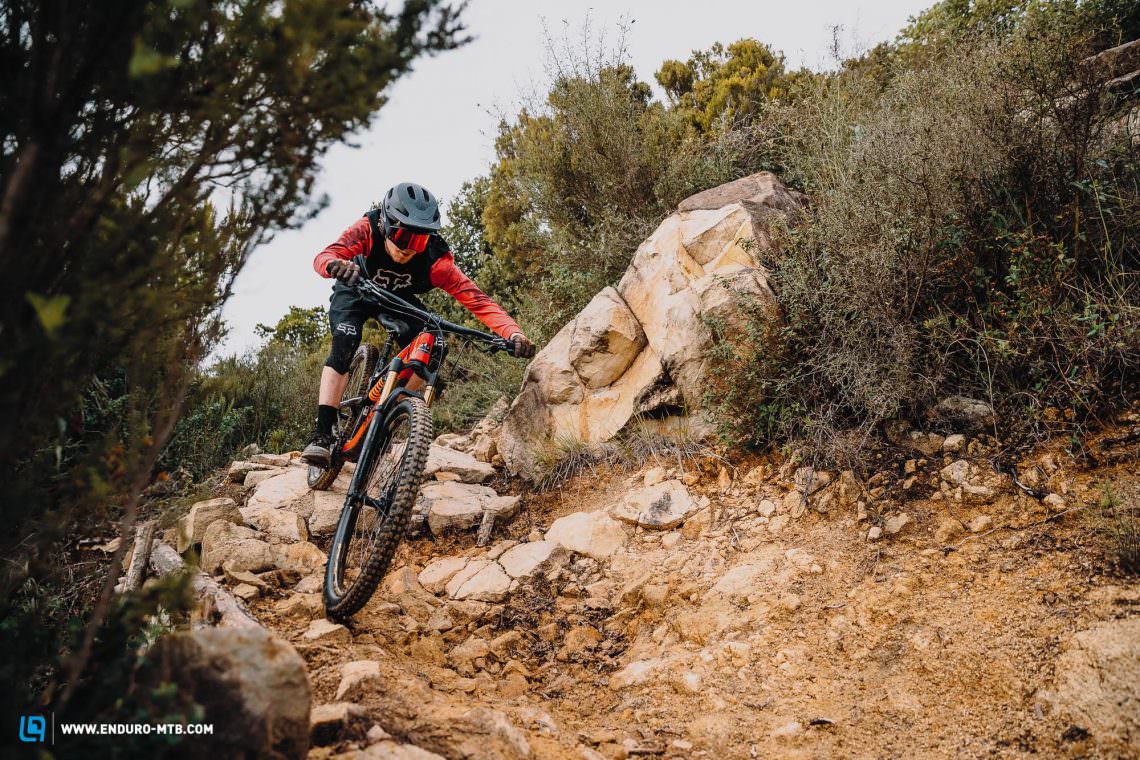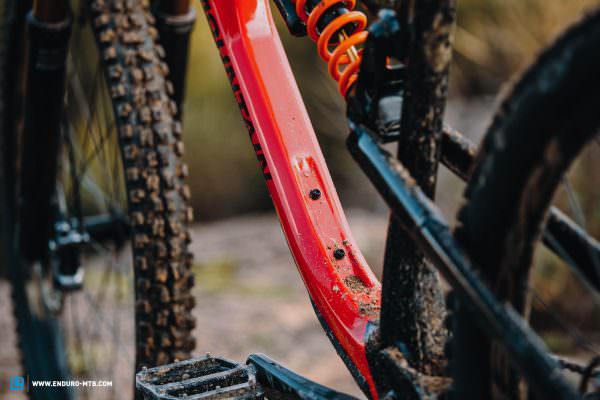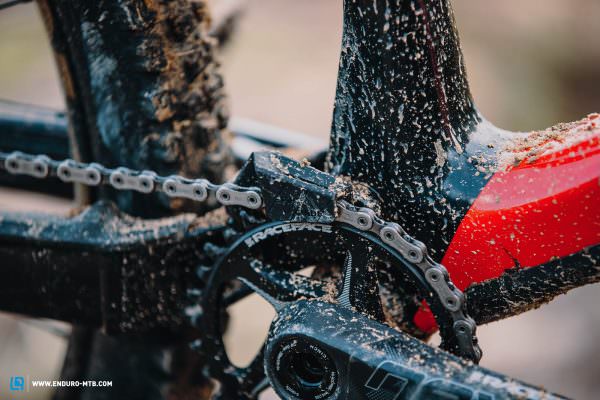The old Rocky Mountain Slayer gained a cult following but it’s been completely redesigned for the new season. For the first time, you have the option of 29″ wheels and thanks to its capable suspension and radical geometry, it promises to make the wildest trails look tame. In the end, it turned out to be one of our test crew’s favourite bikes. Read on to find out why.
For an overview of the test fleet head to the group test: The best enduro bike 2020

The guys and girls at Rocky Mountain didn’t accept any compromises when they developed this bike. Consider the new suspension kinematics with reduced anti-squat for less pedal kickback and the build, and you’ll quickly realise that the Slayer was designed for maximum downhill performance. The Rocky Mountain is one of the few bikes in the test field that comes fitted with tires appropriate for its intended application, with MAXXIS’ Doubledown casing featuring at both ends. You also get powerful Shimano XTR brakes, an integrated chain guide and robust wheels to complete the package. For the suspension, Rocky Mountain spec the € 8,600 flagship Slayer Carbon 90 with FOX Factory components consisting of a 170 mm 36 GRIP2 fork and a DHX2 coil shock, providing 170 mm travel at the rear. We were less pleased with the stiff and wide 820 mm Race Face SixC handlebar and very short 40 mm stem. Of course, you can cut down the bars, but that would only make them even stiffer. The new Slayer features Rocky Mountain’s proven RIDE-4 system, letting you adjust the geometry with four different positions.

With the FOX DHX2, it pays to spend a little more time finding the optimal setup to realise its full potential. We played around with the compression quite a lot and in the end, we settled on a few more clicks. The coil spring is available in 25 lbs steps – with a rider weight of about 85 kg, the 475 lbs coil was ideal.

The internally routed cables on the Slayer are guided effectively and in combination with the large chainstay protector, there’s no rattling to be heard.

The chain guide has been developed by Rocky Mountain in-house and is attached directly to the chainstay – nice!
Rocky Mountain Slayer Carbon 90 29
€ 8,600
Specifications
Fork FOX 36 Factory GRIP2 170 mm
Rear Shock FOX DHX2 Factory 170 mm
Seatpost FOX Transfer Performance Elite 150 mm
Brakes Shimano XTR 4-Kolben 200/200 mm
Drivetrain Shimano XTR M9100 32 - 10/51
Stem Rocky Mountain 35 40 mm
Handlebar Race Face SixC 820 mm
Wheelset Race Face ARC30 / DT Swiss 350 29
Technical Data
Size M, L, XL
Weight 15.2 kg

The cockpit of the Slayer couldn’t convince any of our test riders: they all agreed, the stem is too short and the handlebar too wide. We recommend an upgrade here.

If you ride steep and challenging trails, you’ll need braking power – all the better that the Rocky Mountain comes specced with 203 mm rotors front and rear.

It’s easy to save weight with light tires, but it always comes at the expense of downhill performance. All the better that Rocky Mountain don’t compromise here and fit robust Doubledown tires.

The head angle is super slack in the lowest setting of the RIDE-4 system, measuring 63.8°. We recommend using this setup only for very, very steep trails. On less extreme trails, we found a slightly higher setting to be the better choice.
Geometry and size of the Rocky Mountain
The new Slayer features Rocky Mountain’s proven Ride4 system, allowing you to adjust the geometry in four positions. Because of the slack head angle, we prefered riding the bike in the neutral setting (position 3). Although it doesn’t have a super long reach, it was one of the most capable descenders on test.
| Size | M | L | XL |
|---|---|---|---|
| Seat tube | 420 mm | 445 mm | 480 mm |
| Top tube | 600 mm | 628 mm | 657 mm |
| Head tube | 95 mm | 110 mm | 125 mm |
| Head angle | 63.8° | 63.8° | 63.8° |
| Seat angle | 75.8° | 75.8° | 75.8° |
| Chainstays | 443 mm | 443 mm | 443 mm |
| BB Drop | 34 mm | 34 mm | 34 mm |
| Wheelbase | 1,220 mm | 1,249 mm | 1,286 mm |
| Reach | 442 mm | 469 mm | 492 mm |
| Stack | 622 mm | 635 mm | 649 mm |

The Rocky Mountain Slayer Carbon 90 29 on the trail
As soon as you swing a leg over the Rocky Mountain Slayer, your jaw will drop – there’s no other bike on test with such sensitive and plush feeling suspension. However, there’s also a noticeable amount of pedal bob, so you’ll automatically reach for the shock’s climb switch when you start pedalling uphill. With the climb switch engaged, the Slayer is a capable climber. But really, it’s once the trail heads downhill that you’ll notice what the Slayer’s greatest strength is: enormous amounts traction. The bike glides over the trail like a flying carpet and absorbs even the slightest irregularities. Even so, the suspension still offers enough support to pop off things. It’s only in the corners that the suspension sags a bit too much – a trait that we’ve observed with the FOX DHX2 quite often in the past.
If you know the trails of North Vancouver, you’ll know what the Slayer was made for: steep descents with big holes and nasty roots!

The Slayer feels enormously stable in demanding terrain and paired with the generous reach (469 mm size L) and short seat tube, it makes you feel indestructible when things get steep. Due to the fact that the bike isn’t overly long, it remains easy to control even through tight sections and responds well to the rider’s input. Our only gripe is the feel of the steering. The slack head angle coupled with the slightly sagging rear suspension, the short stem and the super wide handlebars give the front wheel a will of its own and it has to be kept under control with a very active and as a result, exhausting riding style. You have to keep your weight on the front and sudden hits are very hard on your upper body. Besides shortening the handlebars and mounting a longer stem, we advise adjusting the RIDE-4 system to a higher setting.
Stay alert – if you ride the Slayer in the low setting, you’ll have to keep an eye on the front wheel!

How does the Rocky Mountain Slayer compare to the competition
The Rocky Mountain Slayer and the RAAW Madonna are very similar. The rear suspension on the Slayer is even more sensitive and offers more traction on the descents – at least with the different shocks. Both bikes are very similar in tight sections, with the RAAW being a little more balanced and good-natured, conserving your energy on long runs. Compared to the Nukeproof Mega 290C and the RAAW you have to work the Slayer harder to keep the front wheel tracking and on line, but the handling is a bit more lively.

Tuning tip: narrower handlebar with more flex | a 50 mm stem | for everyday use, set RIDE-4 to position 3 (neutral) | replace the Aggressor tire on the rear wheel


Conclusion
The Rocky Mountain Slayer Carbon 90 confirms the positive impression it left us with after our first ride review in Canada. The incredibly sensitive rear suspension offers plenty of traction, and thanks to the moderate reach, it performs just as well in tight sections as on high-speed terrain. Unfortunately, the steering geometry wasn’t quite as convincing – you’ll have to make a few changes here to improve the bike’s all-round performance.
Tops
- incredibly sensitive rear suspension
- considered and high-quality spec
- good pedalling position on the climbs
Flops
- front wheel likes to wander
- climb switch required for the climbs
- Aggressor tire on the rear wheel isn’t very versatile
You can find out more about the Rocky Mountain Slayer Carbon 90 29 at bikes.com
The test field
For an overview of the test fleet head to the group test: The best enduro bike 2020
All bikes in test: Canyon Strive CFR 9.0 LTD | CUBE Stereo 170 SL 29 | Giant Reign Advanced 29 0 | Ibis Mojo HD5 | Norco Sight C1 29 | Nukeproof Mega 275C RS | Nukeproof Mega 290C Pro | Orbea Rallon M-LTD | Pole Stamina 180 LE | RAAW Madonna V2 FOX Factory Built | Rocky Mountain Slayer Carbon 90 29 | Santa Cruz Megatower CC X01 Reserve | SCOTT Ransom 900 Tuned | Specialized S-Works Enduro 2020 | Specialized Turbo Kenevo Expert | Trek Slash 9.9 X01 AXS | Yeti SB150 T2 | YT CAPRA 29 CF Pro Race
Did you enjoy this article? If so, we would be stoked if you decide to support us with a monthly contribution. By becoming a supporter of ENDURO, you will help secure a sustainable future for high-quality mountain bike journalism. Click here to learn more.
Words: Photos: Christoph Bayer / Finlay Anderson / Markus Frühmann









